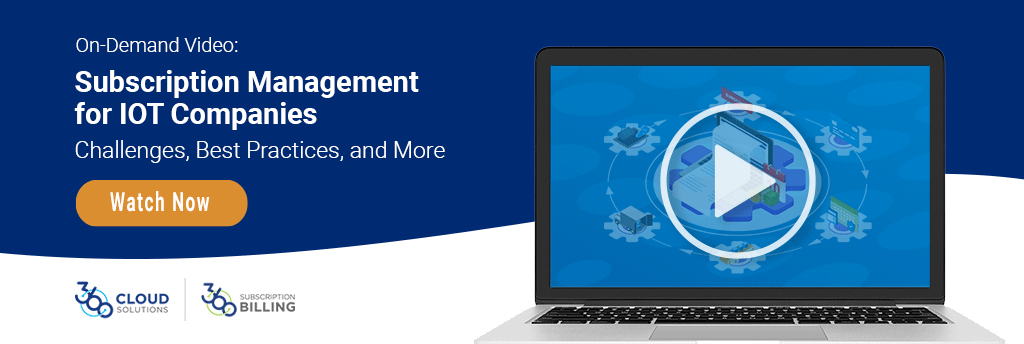Internet of Things (IoT) device manufacturers are often trailblazers by necessity, but this doesn’t have to extend to billing. In fact, this focus on creating innovative solutions can cause problems when it comes to billing for devices and related subscription services. IoT device and service billing can carry complexities that can ultimately derail company growth.
Below, we outline four common IoT billing challenges. By proactively addressing these challenges, IoT companies will find they can better serve their customers and more efficiently scale their business.
1. Billing processes developed around device, not subscription, sales
Perhaps the biggest challenge to IoT billing is the simplest to avoid because it’s a challenge that IoT businesses put in place themselves. It comes from implementing business processes that prioritize device sales first, with subscription service as a second-place consideration.
The assumption for some IoT startups is that the device, as the more complex product offering, should be the priority when it comes to building business processes. Yet this overlooks the central role that subscription services play in your device’s value proposition.
For many IoT device manufacturers, their enterprise’s true value lies in its ability to capture recurring revenue through subscriptions and extend customer lifecycles. As a result, it’s critical to put processes in place that ensure streamlined service and manage all of the variables that will impact service offerings after initially shipping that first device.
2. Managing changes over device and subscription lifecycle
For all that subscription services are becoming a staple of sales offerings today, subscription sales models can add significant IoT billing challenges. That’s because, within any given billing period, subscription levels can change, pause, or be attached to an entirely new device. This requires a system that is able to decouple device management from the subscription and bill these two areas separately. Companies that aren’t prepared to manage these nuances are prone to the types of billing errors that can drive up customer churn.
Rudimentary subscription billing systems might provide knowledge about the current state of a subscription, but can’t always provide clear insight into historical transactions. When a customer who has been with you for several years suddenly has a question about when their subscription actually started, or changes service levels, or has a surprise change in billing, it’s important to have a record of the entire subscription lifecycle, not just the billing cycle since the last change in subscription service.
3. Billing solutions that limit scalability
Most startup companies begin with a spreadsheet-based accounting system or a basic system like QuickBooks. When you’re tracking a limited number of device sales, there’s not much wrong with this approach. However, the complexity of subscription billing is compounded as device sales grow. This is where data-entry errors and data management shortcomings begin to be felt by your customers and your bottom line.
While many companies face this challenge of needing new systems as they grow, IoT companies are uniquely challenged by the lack of off-the shelf-solutions that manage the variation in subscription billing. So, what do they do? More often than not, they turn to their in-house product development team to create a more effective solution. The challenge here is that this now makes your product development team responsible for driving updates for two separate systems that service very different purposes. As your business grows, it will require more staff to manage these dual systems. At some point, they will need to diverge and decouple.
A better alternative is to implement a sales management and subscription billing solution that can grow with your business. Today, there are add-ons and plug-in solutions that can be integrated into leading enterprise management software.
Ilan Horstein, Chief Legal Officer & Head of Business Operations for the IoT company Nauto, points out that it’s much more effective to implement this type of billing software in the startup phase of your IoT business, to prevent IoT billing challenges from accumulating over time.
“It’s like a moving train: the longer you wait, the harder it is to catch that train. When the train is just leaving the station, it’s easy to jump on. Trying to catch up and get to speed and make a working transition is very difficult. In my opinion, you want something like 360 Subscription Billing, which has led us to 100% automated invoicing… We are now able to wake up in the morning on the first day of the month with all of our invoices already sent by email to our customers. That is an amazing success—and you want that right from the beginning,” Horstein says.
For more information, get our FREE GUIDE, 5 Critical Mistakes that Limit Scaling and Growth.
4. Tracking growth and recognizing revenue
Your IoT device might be the heart of your company but what your investors really care about, and what is most likely going to build the value of your organization, are device subscriptions that deliver recurring annual revenue. But you need to have a clear system in place that can track sales and show growth over time and perform revenue recognition even as subscription services change. That all begins with appropriate subscription management tools.
This type of tracking is why many businesses make the move to a financial ERP like NetSuite, with its streamlined financial reporting and Advanced Revenue Management modules. However, NetSuite itself does not have a standard module for managing IoT subscriptions. This is where solutions like 360 Subscription Billing, which manages subscriptions and simplifies financial reporting through its integration into NetSuite, becomes invaluable.
Want to learn more?
Check out this video discussing Subscription Management for IOT Companies: Challenges, Best Practices, and More.




